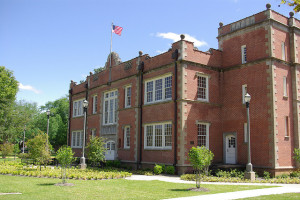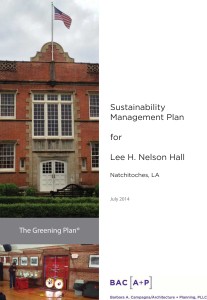
The Lee H.Nelson Hall in Natchitoches, LA , the headquarters of NCPTT, is the focus of a “greening plan.”
As Kurt Vonnegut has been quoted as saying, “Another flaw in the human character is that everyone wants to build and nobody wants to do maintenance.” NCPTT in Natchitoches, LA , has undertaken a sustainability management plan for its headquarters in the the Lee H. Nelson Hall, with ongoing and cyclical maintenance as its primary goal. Can a historic building improve its resource efficiency while protecting its historic features? This is what this model project is seeking to prove.

“The Greening Plan” for the Lee H. Nelson Hall can be downloaded in its entirety from the NCPTT website.
A Model Project
The construction and operation of buildings accounts for almost 50% of greenhouse gas emissions in the U.S. But reusing and retrofitting our existing buildings can reduce these emissions dramatically. Historic and existing buildings, such as the National Center for Preservation Technology & Training’s Lee H. Nelson Hall, are seeking to improve their maintenance programs and capital improvement approaches by combining time-tested preservation methods with green building practices.
The Lee H. Nelson Hall project team is integrating the use of green building tools and LEED rating systems with preservation planning methodology to improve the energy and resource use of the site and lower the bottom-line. The guiding premise for this project is that its recommendations should meet energy and sustainability goals while preserving the character-defining and historically significant features. One of the major goals of this project is to reduce energy and resource use while saving operations’ funds, a goal that most buildings aspire to. By using the greening of their headquarters as a transparent model process, which can be shared with the field, NCPTT is leveraging their significant place in preservation research while demonstrating how to be a better steward. NCPTT has posted the full sustainability management plan on their website and it can be downloaded here.
The Past and Future in the Bayou

Marcus Eliason from Apollo BBC studies energy loss in the Lee H. Nelson Hall with the assistance of an infrared tool.
The building was originally constructed in 1923 in Natchitoches, LA and designed by the New Orleans firm of Favrot and Livaudais as a classroom building and activity center for the campus of what is now Northwestern State University (NSU). Once the Hall was no longer large enough to serve the student body, it was closed. After 30 years of use as a storage facility, a new department of the National Park Service, the National Center for Preservation Technology and Training, was located in the building in 2001. The purpose of the project and the process is to develop a road map for greening the maintenance and operations procedures of all existing and historic buildings. By using the growing body of sustainable preservation case studies, understanding the original character-defining features of the building and integrating the necessary envelope, systems and site improvements with acknowledged green building practices, NCPTT has decided to use the LEED EB: O&M rating system (targeting LEED Gold), often called a cyclical maintenance plan on steroids, as the metric to guide both the maintenance and capital improvements approaches at the site.
The Sustainability Management Plan Process

The full client and design team develops project goals and objectives in the Lee H. Nelson Hall eco-charrette.
A series of eco-charrettes, energy audits, a sustainability management plan and LEED EB:O&M, are being used to improve the resource use and efficiency of the site. The first goal-setting eco-charrette was conducted in January 2013 and the full sustainability management and LEED plan completed one year later. Using their historic building as the test case for this greening process, NCPTT will demonstrate that the use of green building analysis tools, in conjunction with preservation methodologies, can lead to a plan for efficient environmental actions that improve long term stewardship; and will show how new technologies and reactivation of original design features can together provide innovations in green building design while debunking the myths that historic buildings cannot readily achieve LEED certification. NCPTT acknowledges the importance of a strong maintenance program and this sustainability management plan is one way forward. The project team includes BAC/Architecture + Planning PLLC from Buffalo/NYC and Apollo BBC from Houston. We will be presenting this project at Greenbuild in New Orleans next month. So if you would like to learn more about the project and you’ll be in NOLA for the conference, please feel free to join us on Wednesday, October 22nd at 8AM. Or contact me via email [email protected].
And if you’d like to “subscribe” or follow my blog, True Green Cities, please sign up through the “Subscribe” button at the bottom left of this page. You’ll receive a daily recap when new blogs are posted. Or Sign up for the Feed.
